You might not realize how pivotal key recalls have been in shaping motorcycle history, especially with brands like Ducati. Early models faced significant challenges, from engine malfunctions to electrical failures, raising serious safety concerns for riders. These issues didn't just spark recalls; they ignited a movement towards improved quality and rider safety. As we explore the historical context and the lessons learned, you'll find that the evolution of motorcycle design is closely tied to community feedback and innovation. What might surprise you are the lasting impacts these challenges have had on the industry today.
Key Takeaways
- Early motorcycle models, including those from Ducati, often faced mechanical failures such as clutch and electrical system issues affecting reliability.
- Major recalls, like the 2006 Ducati 999 for fuel leaks, highlighted safety concerns impacting brand reputation and consumer trust.
- Design flaws in early models, particularly inadequate cooling systems, led to overheating and compromised performance and safety.
- Customer feedback has been crucial in driving design improvements and innovations in motorcycle safety features over time.
Overview of Ducati Motorcycles
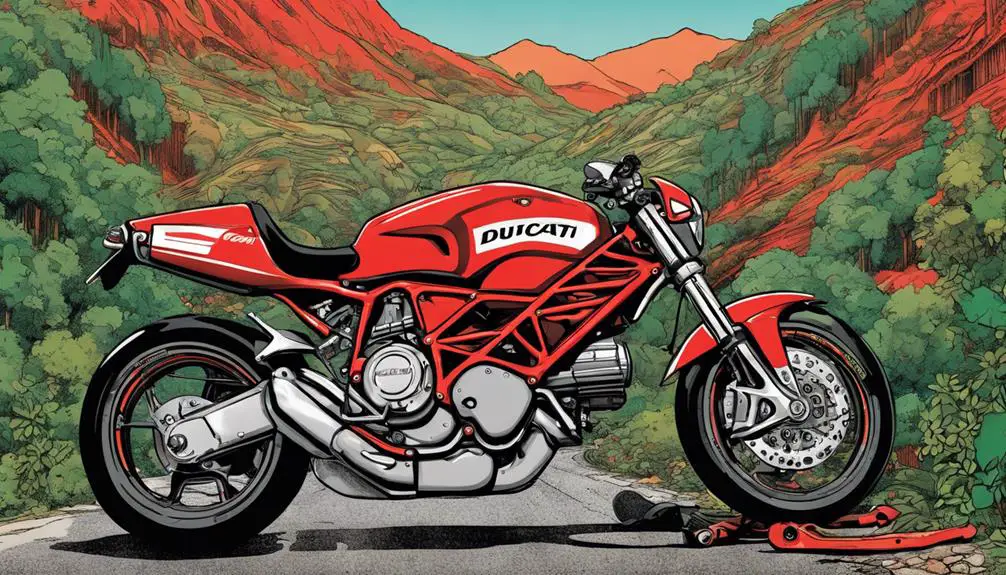
Ducati motorcycles, known for their distinctive design and performance, have carved out a unique niche in the motorcycling world. When you hop on a Ducati, you're not just riding; you're embracing a culture of freedom and adrenaline. With their bold lines and vibrant colors, these machines demand attention and inspire passion.
You can feel the power of the engine as you twist the throttle, releasing a roar that echoes your desire for adventure. Ducati's innovative engineering combines cutting-edge technology with a racing heritage that's palpable in every ride. Whether you're carving through winding roads or taking on the racetrack, the bike's responsive handling and superior performance allow you to reveal your true potential.
Every detail, from the ergonomics to the aesthetics, reflects a commitment to excellence that resonates with riders who crave liberation. When you choose Ducati, you're not just getting a motorcycle; you're joining a community of like-minded individuals who value freedom, performance, and style.
It's time to embrace the thrill of the ride and experience the exhilarating world of Ducati motorcycles, where every journey becomes a celebration of your adventurous spirit.
Early Ducati Models and Issues
When you think about early Ducati models, it's crucial to reflect on the mechanical failures that plagued them.
You'll find that safety recalls highlighted significant concerns, while design flaws further complicated their reputation.
Let's explore these issues to understand how they shaped Ducati's legacy.
Mechanical Failures Overview
Early Ducati models frequently faced mechanical failures that impacted their reliability and performance. You might recall the struggles with clutches and electrical systems, which often left riders feeling stranded or frustrated. The early 750 Sport, for instance, had issues with its gearbox that could lead to sudden shifts or even catastrophic failures. This unpredictability didn't just dampen the thrill; it threatened your safety and freedom on the open road.
You also couldn't ignore the common problems with overheating engines. Many riders found themselves dealing with excessive heat, which could warp components and lead to expensive repairs. It felt like a betrayal from a brand that promised excitement and adventure.
Despite these setbacks, the passionate Ducati community often rallied together, sharing fixes and modifications to overcome these flaws. You might've even been inspired by the DIY spirit that emerged, where creativity filled the gaps in engineering. Embracing this camaraderie allowed you to reclaim your ride's potential, making it a journey of self-discovery and empowerment.
While the road was bumpy, the lessons learned shaped a deeper connection to the motorcycle culture and the quest for liberation on two wheels.
Safety Recall Highlights
Amidst the enthusiasm for riding early Ducati models, safety recalls emerged as a significant concern, addressing various issues that could compromise rider safety. You love the thrill of the ride, but it's vital to stay informed about potential hazards that could affect your experience. Recognizing these recalls can be the difference between a smooth ride and an unsafe situation.
Here are some of the key safety recalls you should be aware of:
- Brake System Failures: Some early models had issues with brake components that could lead to reduced stopping power.
- Electrical Problems: Faulty wiring in certain models raised fire risks, making it essential to check for recalls.
- Fuel Leaks: Inadequate sealing in fuel systems posed a fire hazard, warranting immediate attention.
Staying vigilant about these recalls not only protects you but also keeps the spirit of freedom alive in your riding experience. By being proactive, you can enjoy the open road with confidence and peace of mind.
Design Flaws Analysis
Design flaws in early Ducati models often led to significant performance issues, impacting both safety and the overall riding experience. You might remember those classic bikes that were meant to exude freedom and adventure. However, many riders found themselves grappling with unexpected challenges.
For instance, the early Ducati 750SS faced overheating problems due to inadequate cooling systems. This flaw could leave you stranded on the side of the road, dampening your spirit of exploration.
Another concern was the faulty electrical systems that often failed, causing lights to flicker or even die while riding. This lack of reliability could be unnerving, especially when you're on a winding road or a deserted highway. Additionally, the brakes on some early models had inconsistent performance, which could compromise safety when you needed it most.
Understanding these issues is vital for any bike enthusiast. It helps you recognize the evolution of design in pursuit of that exhilarating freedom you crave. While early Ducati models may have had their flaws, they also paved the way for advancements that ultimately improved performance and safety, allowing you to ride with confidence.
Major Recalls in Ducati History
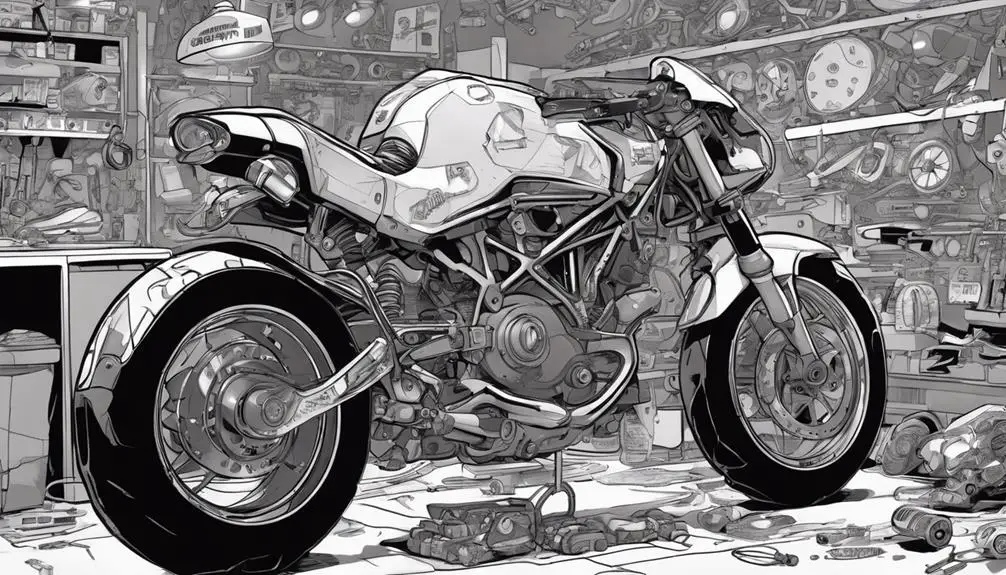
When you think about Ducati, it's important to recognize the major recalls that have shaped its history.
These recalls not only affected the brand's reputation but also provided valuable lessons for future models.
Let's explore these notable issues and their impact on Ducati as a whole.
Notable Ducati Recalls
Ducati's history is marked by several significant recalls that have shaped the brand's reputation and safety standards. These recalls haven't only addressed safety concerns but also demonstrated the company's commitment to rider well-being. As a passionate rider, you should be aware of these key issues to guarantee your Ducati experience remains thrilling and safe.
In 2002, the Monster 620 suffered from an issue that caused the rear brake to fail, prompting a recall to replace faulty components.
The 2006 999 model faced a recall due to potential fuel leaks, which could pose a fire hazard.
Riders of the 2010 Multistrada 1200 found themselves in a recall for defective brake pads that could lead to decreased stopping power.
A recall in 2017 affected the Panigale models, addressing issues with the quick-shifter that could lead to unexpected gear changes.
Impact on Reputation
Major recalls in Ducati's history have greatly impacted the brand's reputation, shaping how riders perceive safety and quality in their motorcycles. When you think about Ducati, you might feel a mix of excitement and apprehension, especially after hearing about those significant recalls. You want to ride with confidence, knowing that your bike won't let you down. Each recall raises questions about the craftsmanship and reliability that Ducati promises.
For many, a recall can tarnish the allure of owning a Ducati. You might find yourself second-guessing your choice, wondering if the thrill of the ride is worth the potential risks. The brand's commitment to safety and performance can feel compromised, making you more cautious.
Yet, Ducati's proactive approach to addressing issues can also demonstrate their dedication to rider safety. When they act swiftly to rectify problems, it signals to you that they value your experience and well-being.
Ultimately, while recalls can dent a brand's image, they also present an opportunity for Ducati to reaffirm its commitment to quality, empowering you to make informed choices about your ride in the future.
Lessons Learned Over Time
Over the years, Ducati has faced significant recalls that have taught valuable lessons about safety, quality control, and the importance of customer trust. Each incident pushed the brand to reevaluate strategies and prioritize rider safety above all else. As a passionate rider, you can appreciate how these challenges have shaped Ducati's commitment to excellence.
Here are some key takeaways from major recalls in Ducati's history:
- Prioritize Safety: Always place rider safety at the forefront of design and manufacturing.
- Transparent Communication: Keep open lines of communication with customers to build trust and loyalty.
- Routine Quality Checks: Implement stringent quality control measures throughout the production process to catch issues early.
Ducati's journey through these recalls serves as a reminder that even the most passionate brands aren't immune to challenges. By embracing these lessons, Ducati continues to evolve and inspire a generation of riders who seek freedom and adventure on two wheels.
You can ride knowing that each lesson learned contributes to a safer and more exhilarating experience.
Engine Problems and Solutions
Engine problems can be frustrating, but understanding common issues and their solutions can help you keep your motorcycle running smoothly.
One frequent issue is overheating. Confirm your coolant levels are adequate and check for leaks. A dirty air filter can also restrict airflow, reducing engine efficiency. Clean or replace it regularly to maintain peak performance.
Another common problem is a misfiring engine. This often stems from faulty spark plugs or improper fuel mixture. Make it a habit to inspect your spark plugs and adjust your fuel mixture to combat this issue. If you notice a drop in power or unusual noises, it could indicate a serious problem, like a failing piston or valve. Don't hesitate to consult a mechanic if you're unsure.
Regular maintenance is vital in preventing these issues. Change your oil as recommended, keep your chains and belts lubricated, and check your fuel system for blockages.
By staying proactive and attentive, you'll not only liberate yourself from future headaches but also enhance your riding experience. Your motorcycle deserves the best care, and you're more than capable of providing it.
Ride free and stay informed!
Electrical System Failures
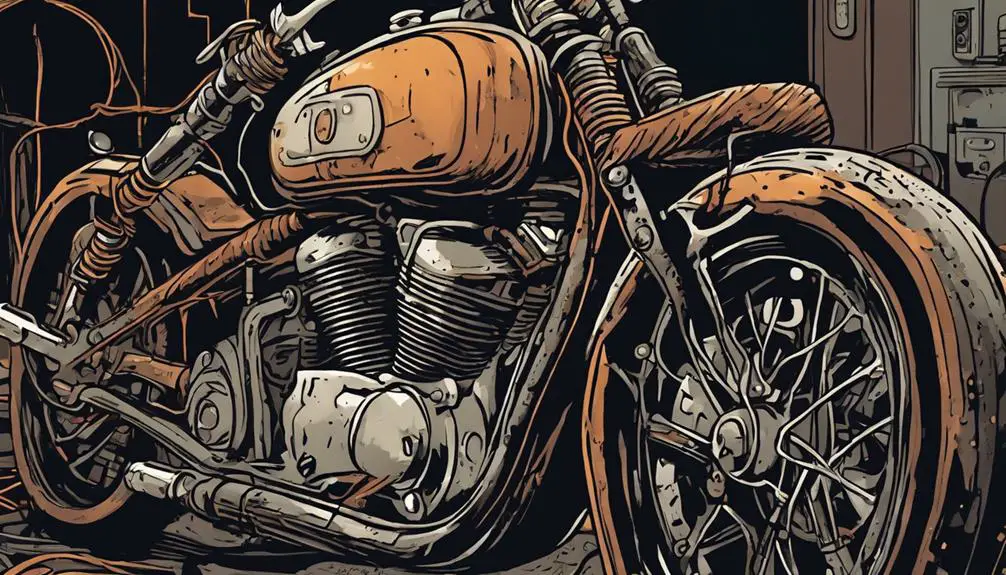
Electrical system failures can leave you stranded, so recognizing the signs early is essential for a smooth ride. You depend on your bike's electrical components for everything from ignition to lights, and when something goes awry, it can ruin your freedom on the open road.
Keep an eye out for these common indicators:
- Flickering Lights: If your headlight or taillight starts acting erratically, it's a sign that your electrical system may be struggling.
- Dead Battery: A battery that won't hold a charge can mean trouble ahead. Regular checks can save you from a frustrating halt.
- Unresponsive Dashboard: If your gauges or indicators are dead, it could point to a failing electrical connection.
Suspension and Handling Concerns
Your motorcycle's suspension plays an essential role in ensuring a smooth ride and maintaining control, so any issues in this area can greatly impact your handling and overall safety on the road. If your suspension isn't functioning properly, you'll notice it in how your bike responds to bumps, turns, and even straightaways. A poorly adjusted or worn suspension can lead to a shaky ride, making you feel less in command of your machine.
When you're out there, freedom calls for a ride that feels connected, not bumpy and unpredictable. Check for signs like unusual bouncing, excessive diving when braking, or a lack of response in corners. These aren't just annoyances; they can lead to serious safety concerns.
Regularly inspect your shocks and forks, and don't hesitate to replace them if they've seen better days. After all, every ride should be about liberation, not tension. Trust your instincts—if something feels off, it probably is.
Addressing suspension problems means you can enjoy that open road without fear, embracing the thrill of the journey. Your bike deserves the best; so do you.
Customer Feedback and Impact
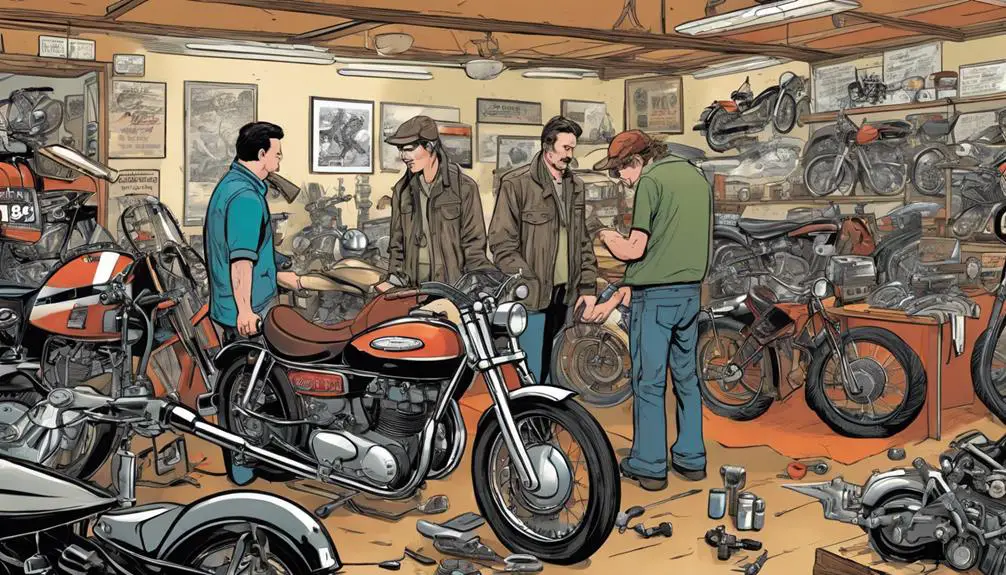
How do customer experiences shape the evolution of motorcycle design and safety features? When you share your thoughts and feedback, manufacturers take notice. Your insights directly influence how bikes are built, ensuring they're safer and more enjoyable to ride. This two-way communication leads to significant advancements that cater to what you truly need.
Consider these key impacts of customer feedback:
- Design tweaks: Riders often share their preferences, leading to more ergonomic and user-friendly designs.
- Safety enhancements: Concerns about safety trigger manufacturers to prioritize better braking systems, lights, and visibility features.
- Performance upgrades: Riders provide insights on handling and speed, prompting enhancements in engine power and suspension systems.
Ultimately, your voice matters. By voicing your experiences, you not only elevate your riding experience but also contribute to a culture that values innovation and safety.
Innovations and Safety Improvements
Innovations in motorcycle technology have considerably enhanced safety features, ensuring riders enjoy a more secure and confident experience on the road.
You've likely noticed the rise of anti-lock braking systems (ABS), which prevent wheel lock-up during sudden stops, allowing for better control in emergencies. This feature can be the difference between a close call and a serious accident.
Another significant advancement is traction control, which helps maintain grip in challenging conditions. When you twist the throttle, this system monitors wheel slip and adjusts power to keep you stable. It's like having an extra layer of protection, allowing you to focus on the thrill of the ride.
Additionally, advancements in rider visibility, such as LED lighting and reflective materials, make you more noticeable to other motorists. Coupled with helmet technology that now includes built-in communication systems and crash detection, you're not just riding; you're connected and safer than ever.
These innovations empower you to embrace the freedom of the open road while minimizing risks. With these safety features, you can push boundaries, discover new horizons, and ride with the confidence that you're well-equipped for whatever comes your way.
Future of Ducati Reliability
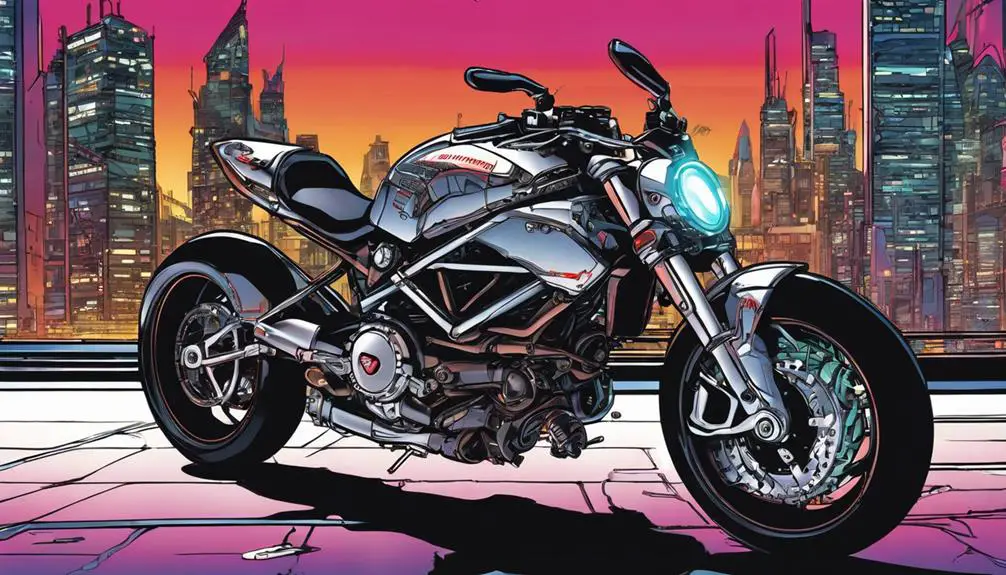
Ducati's commitment to enhancing reliability is set to shape the future of its motorcycles, ensuring they not only deliver performance but also durability and peace of mind for riders. As you embrace the open road, knowing your Ducati can withstand the rigors of your adventures is essential. The brand's focus on reliability will empower you to explore without hesitation.
Here are some key aspects Ducati is prioritizing:
- Advanced Technology: Incorporating cutting-edge materials and engineering practices to boost longevity.
- Regular Maintenance Programs: Offering extensive service plans to keep your bike running smoothly.
- Real-World Testing: Subjecting models to rigorous conditions to identify and resolve potential issues before they reach you.
As Ducati evolves, you can expect motorcycles that not only sing with power but also stand resilient against the demands of the journey.
With each ride, you'll feel the freedom that comes from knowing your machine is built to last, allowing you to focus on the thrill of the ride rather than worries about reliability.
Embrace the next chapter in Ducati history!
Frequently Asked Questions
What Is Ducati's Most Popular Motorcycle Model Ever Produced?
When you think of Ducati's most popular motorcycle, the Ducati Monster often springs to mind.
This iconic bike, introduced in 1993, revolutionized the naked bike segment with its blend of style and performance.
Riders love its raw power and distinctive design, making it a symbol of freedom on the road.
If you're seeking a ride that embodies both agility and passion, the Monster's your ticket to liberation and ultimate riding experience.
How Does Ducati Compare to Other Motorcycle Brands in Reliability?
When you compare Ducati to other motorcycle brands in reliability, you'll find it's often viewed as a bit less dependable than some competitors.
While Ducatis offer exceptional performance and design, their maintenance can be more demanding.
You might enjoy the thrill they provide, but be ready for regular upkeep.
Brands like Honda and Yamaha often score higher in reliability, making them a safer bet for those prioritizing trouble-free rides.
What Is the Average Lifespan of a Ducati Motorcycle?
The average lifespan of a Ducati motorcycle typically ranges between 10 to 15 years, depending on how well you maintain it.
If you regularly service it, keep it clean, and ride responsibly, you can enjoy its performance for many years.
Ducati's engineering is exceptional, but it's essential to respect its needs.
Are Ducati Motorcycles Suitable for Beginners or Novice Riders?
Imagine a powerful stallion ready to gallop; that's a Ducati motorcycle.
While they exude style and performance, they're not always the best fit for beginners. Their high power and unique handling can be overwhelming for novice riders.
If you're looking for liberation on two wheels, consider starting with a more manageable bike.
Once you've built your skills and confidence, then a Ducati can become your trusted steed for thrilling adventures.
What Aftermarket Modifications Are Popular Among Ducati Owners?
When you own a Ducati, you'll likely explore popular aftermarket modifications to enhance your ride.
Many owners opt for performance exhaust systems to boost sound and power. Upgraded suspension components improve handling and comfort, while custom seats offer a personalized touch.
You might also consider aesthetic changes like unique paint jobs or carbon fiber parts.
These modifications not only enhance performance but also reflect your individuality and passion for riding.
Conclusion
To sum up, Ducati's journey through recalls and challenges has shaped its commitment to rider safety and innovation.
For instance, consider the hypothetical case of a rider facing braking issues in a popular model.
Thanks to community feedback and rigorous testing, Ducati develops an advanced braking system, improving performance and safety.
This proactive approach not only addresses past concerns but also fosters trust among riders, ensuring that Ducati remains a leader in the motorcycle industry with a focus on reliability.